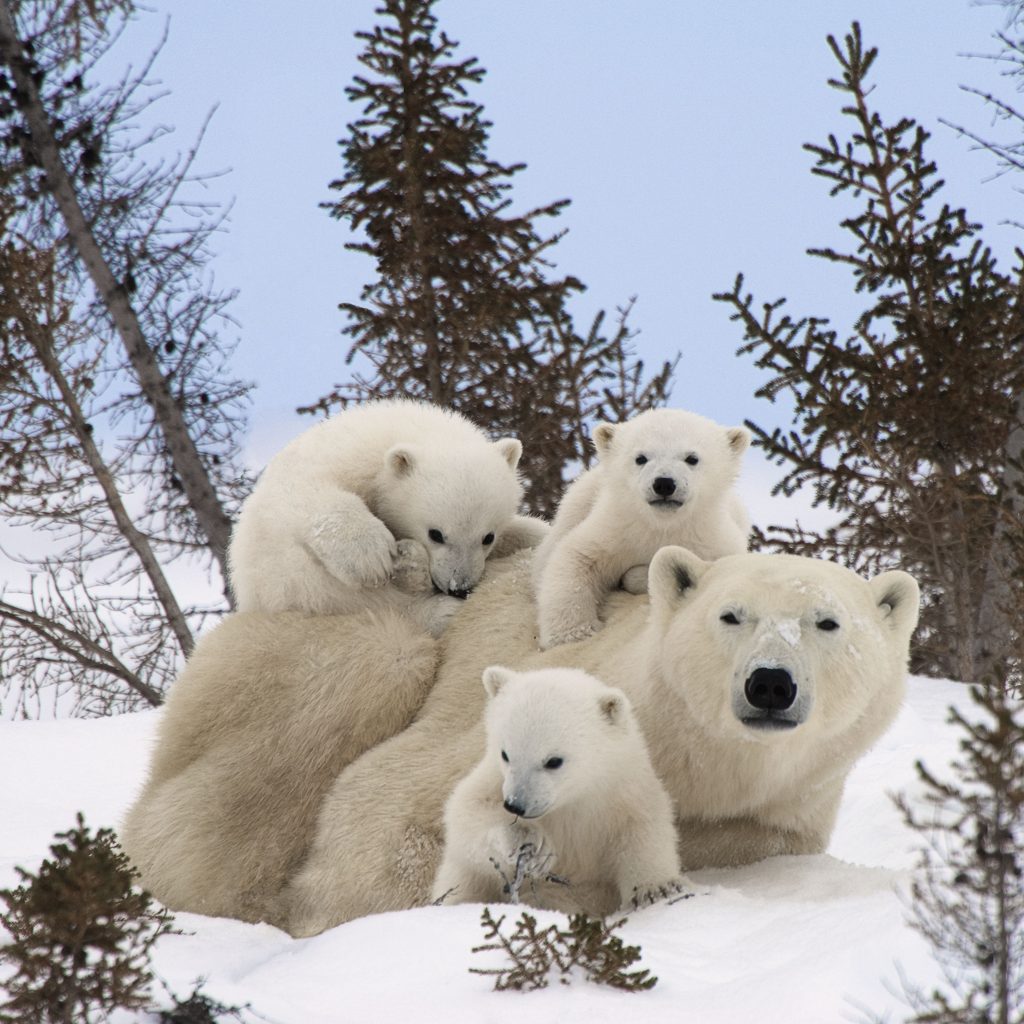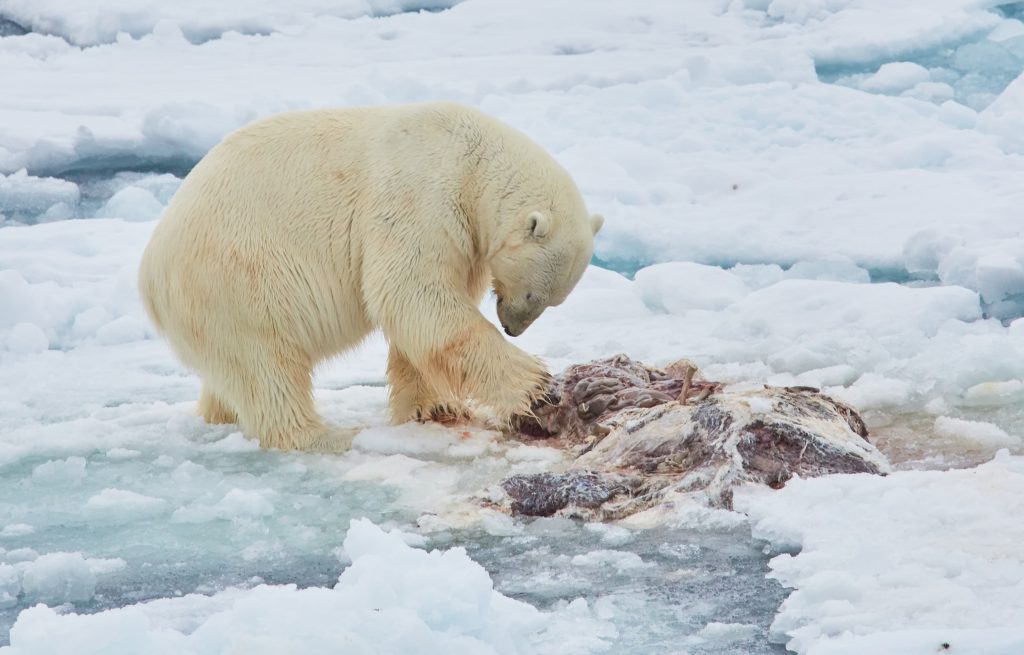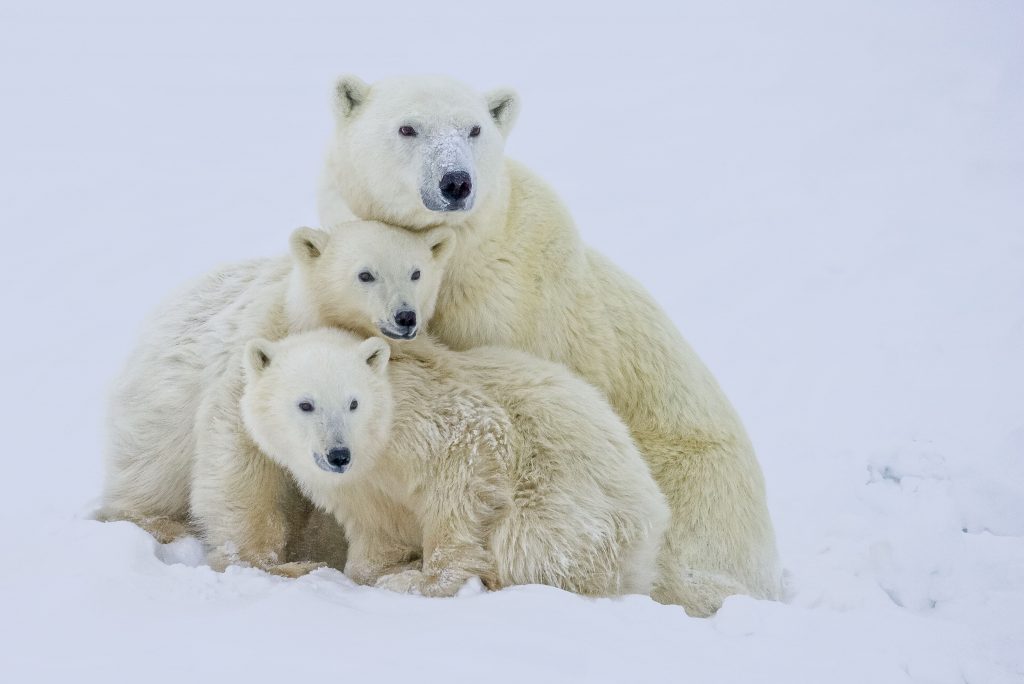Polar bears, sometimes called “white bears” or “ice bears”, are bears that mainly live within the confines of the Arctic circle. It is for this reason they are called polar bears. Although they are land bears, and are born on land, they can more usually be found on Arctic sea ice. Their scientific name is Ursus maritimus. Derived from the fact that they are more often found at sea than on land. Despite being born on land, they are marine animals.
Learn more about this Arctic icon below!
The male polar bear is large, weighing in at 350-700 kg (or 800-1500 lbs). Females are typically half the size of a male polar bear. Males, or boars, can be up to 3 meters (or 10 feet) in length. These bears are among the most sexually dimorphic of mammals. This means the males can be much larger than the females. The largest polar bear on record was 1,002 kg (2,209 lbs) and 3.39 meters tall (11 feet). Polar bears from the ground to the shoulder can have a height of 160 cm (5 feet 3 inches).
Though not considered endangered, they are considered vulnerable. Due to climate change, less sea ice is present each year, which is the polar bears main habitat.
Their most recent ancestor is the brown bear. Both bears are roughly the same size. In addition, fossilized teeth from polar bears have been found and it can be conclusively said that their teeth became distinct from the brown bear 10,000 to 20,000 years ago. It is suspected that some population of brown bears were separated due to glaciation in the Pleistocene era leading to a distinctly different bear. These bears are able to mate with the brown bear giving further evidence that the two bears are related. Interestingly, DNA studies on Irish brown bears shows that these bears are much more closely related to polar bears than other brown bears. DNA studies show that the two cousins diverged about 400,000 years ago genetically. This gets even more complex as these two distinct bears like to mate, likely due to seasonal changes. As the sea ice melts in the summer, polar bears head south and brown bears head north. The result of these bears mating is a fully fertile grizzly-polar bear hybrid. The two bears, though genetically similar, are in different species as they cannot survive in each other’s native h[abitats. Furthermore, the diet, metabolism, social and feeding behaviors, and coat differences also differentiate these bears into two separate species.=

As implied by the name, these bears live around the North pole. They can usually be found within the Arctic Circle. But often they can be seen on the land masses just south of the Arctic Circle, such as Newfoundland in Canada. Since the North pole has not seen much human development, the bears have free range of the Arctic Circle, and have the largest range of any other living carnivore. While these bears live within the Arctic Circle at about 66 degrees N, they are typically not found much more north than the latitude 88 degrees N. Polar bears can be found as far south as James Bay, Canada. There are 19 subpopulations that for the most part stay within the region of the subpopulation. 13 of the 19 subpopulations (54% of all polar bears) live in North America from Beaufort Sea to Hudson Bay to Baffin Bay. The full range of these bears’ habitat includes five countries: Denmark, Norway, Russia, the USA, and Canada. Each of these countries own land either within the Arctic Circle.
As mentioned above, these bears are considered marine animals as they spend most of their time at sea. It is the only marine mammal that can run and cover miles at a time on land. Polar bears looking for food will tend to be found where sea ice meets water. Their primary diet of seals found at the perimeter of the polar ice pack. It is interesting to note that polar bears can produce water through the metabolism of the seal’s blubber.
Global population estimates believe there to be anywhere from 20,000 to 31,000 bears.
The bears will overheat at temperatures higher than 10 degrees Celsius (50 degrees Fahrenheit). Due to their insulation, polar bears are almost invisible under infrared light.
They can run at 25 mph, swim at 6 mph, and move at an average of 4 mph.
The record for longest distance swam is 2,500 km (1,500 miles).
Polar bears are not territorial like their closest cousin, the brown bear. These bears would rather run from a fight than participate. Bears that are fed will flee unless highly intimidated by predators. As the polar bear has been isolated from humans for most of history, they are not familiar with us and may take the chance for a nice meal. Polar bear attacks are almost always fatal as they are stealthy hunters. This is in unlike brown bears. It has been documented that polar bears will wrestle and play in a friendly manner with dogs (namely the Eskimo Dog). This is rare as most bears would act aggressively towards dogs.
The lack of vegetation in the Arctic makes these bears the most carnivorous bear. They primarily eat ringed and bearded seals. The bears do most of their hunting on sea ice where seals will pop up through holes in the ice to breathe. These bears will stealthily wait at a breathing hole for hours, a method called still-hunting. The seal surfaces and is grabbed from the water. The quickest way to kill a seal is for the bear to bite and crush the seal’s head. Polar bears will find and search through seal birthing dens that are buried in the snow. They are also capable of stalking and sneaking up on their prey. The diet changes from a protein-based diet to a fat-based diet, throughout the life of the polar bear. Both of these diets can be sustained from the same seal. When sea ice is not available, as in the summer, the bears live off fat reserves. These bears also do not hibernate.

Yes, these bears are a keystone species. Their kills feed not only themselves, but also Arctic foxes and glaucous gulls. As their main prey, ringed seals density will regulate the amount of polar bears in the area and bears that are born. In return the amount of bears in the area will regulate the amount of seals in the area.
The bears are listed as vulnerable, as it is predicted that a population decline of at least 30% will occur in the next three generations (35 years). The current population of bears is estimated to be between 20,000 and 30,000. The population’s current trend is unknown. The population is at risk due to climate change, shipping conflicts, oil and gas exploration, pollution, and possibly from bear viewing expeditions. The bears are used as a gauge by scientists to study the Arctic ecosystem health.
The bears mate on the sea ice in April and May. Male bears, or bulls, will follow female tracks for 60 miles or more in order to have the chance of mating. It is common that bulls will fight with others for the rights to mate. Bears will mate for one week and then go their separate ways. It is not unheard of for bears in a litter to have more than one father. Female bears, or sows, will then almost double their weight in the four months of gestation. The cubs will arrive in August or September.

Yes. The bears face malnutrition and habitat loss. The amount of sea ice available affects where the hunting, breeding, and birthing of bears will happen. Less sea ice also means that the bears will have to swim longer distances, which can deplete the fat stores they need in the summer months when sea ice is typically less available. This can also lead to drowning. Decreased nourishment leads to decreased birth rates and decreased survival rates of the borne cubs. In addition to all of these issues, bacteria and disease-causing pathogens tend to flourish in warmer temperatures meaning the quality of life for the bears decreases. As mentioned before, the bears are a keystone species so Arctic foxes and gulls will have less food to scavenge as well. As the sea ice disappears, interactions with humans become more likely and fatal attacks follow. This effect has been realized in North Canada, and these bears have begun to eat goose eggs, caribou, and waterfowl.
Ready to find your dream cruise? Have questions? Contact Polar Holidays to schedule a free consultation with one of our booking specialists today!